Have you ever wondered how those vibrant, long-lasting graphics on vehicle wraps, storefront windows, or even large billboards are made? More often than not, the secret lies in a versatile material called "self-adhesive vinyl." It's everywhere, making a huge impact with its ability to transform surfaces into powerful messages.
Self-adhesive vinyl, often referred to as printable vinyl or sticky vinyl, is a thin, flexible film with a pressure-sensitive adhesive layer on one side. This adhesive allows it to stick firmly to various smooth surfaces without additional glues, making it an ideal medium for large-format digital printing in advertising, signage, and decorative applications.
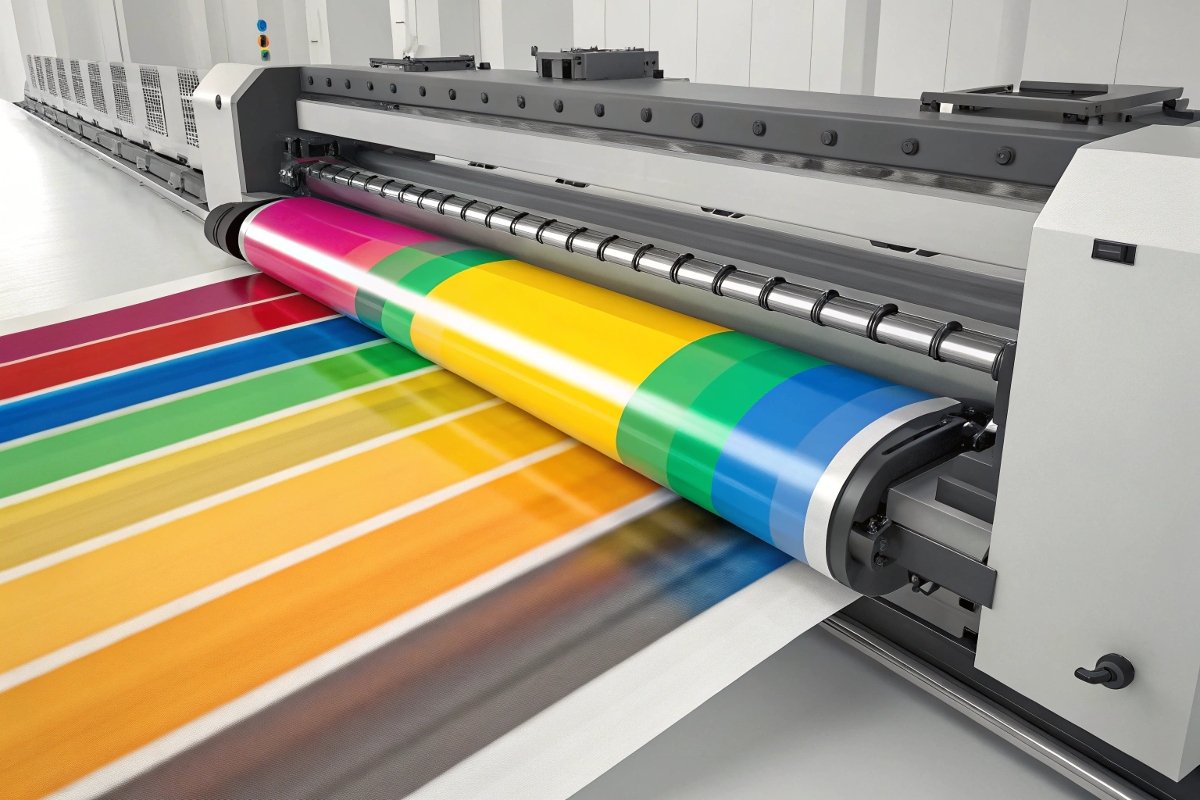
In my decades in the signage and advertising materials industry, self-adhesive vinyl has been a cornerstone. I've seen its evolution from basic signage to intricate vehicle wraps and architectural decorations. It's a product that perfectly combines visual impact with functional durability. When I help partners establish their businesses, introducing them to the vast possibilities of self-adhesive vinyl is always a highlight. It offers consistent quality and vibrant results, which is exactly why professionals like Mr. Watford value it for their diverse purchasing needs.
What is Printable Self-Adhesive Vinyl Made Of?
Understanding the composition helps explain its versatility and performance across different applications.
Printable self-adhesive vinyl is primarily composed of three layers: a durable vinyl film (typically PVC)[^1] as the face material, a pressure-sensitive adhesive layer on the back, and a release liner that protects the adhesive until application. The vinyl film is specially treated to ensure optimal ink absorption for large-format digital printing using inks like UV, eco-solvent, solvent, HP Latex, or water-based inks, and it can also be used for screen printing.
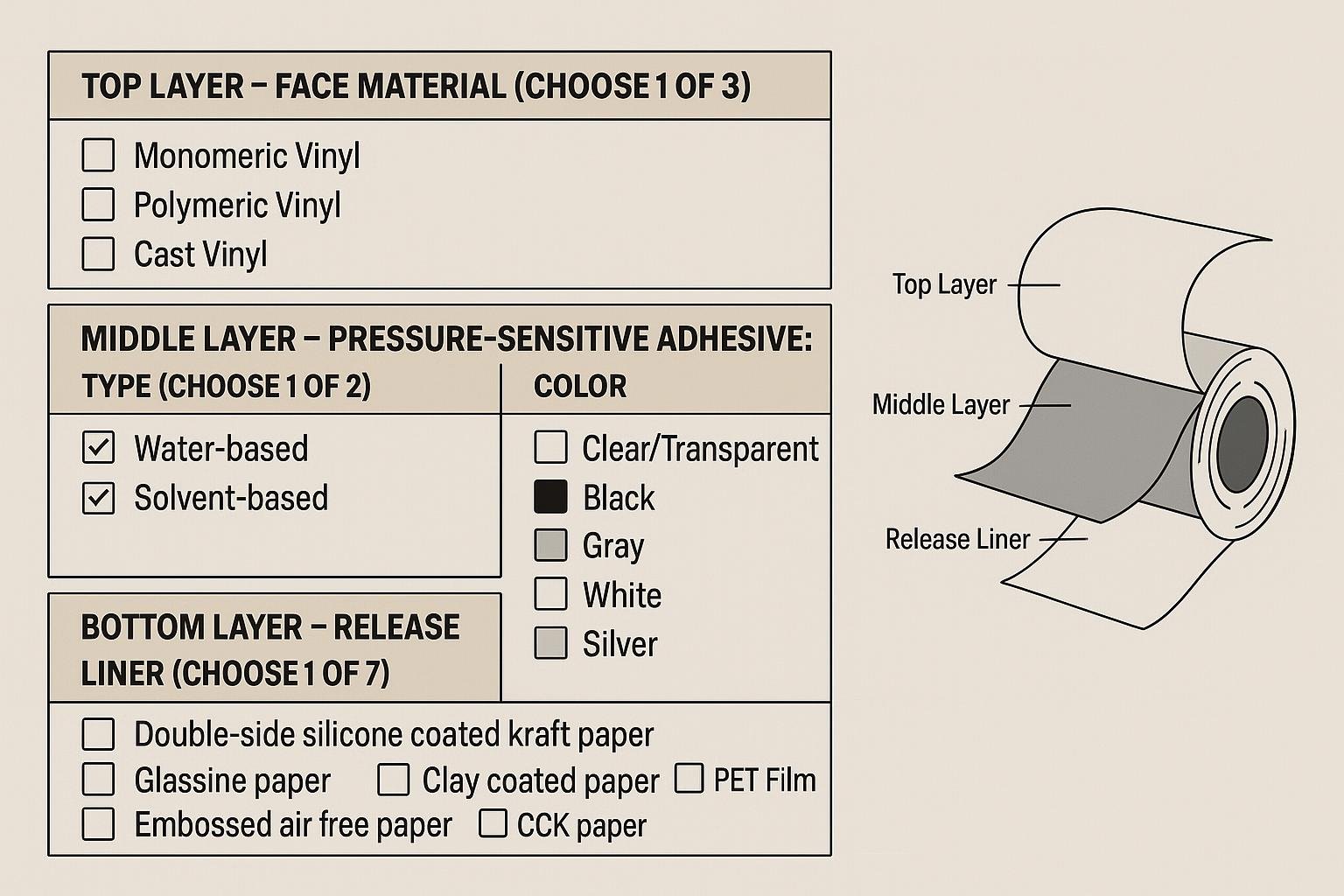
As a manufacturer, I know these layers are critical. The "vinyl film" is the canvas. It's usually made from PVC because PVC offers excellent flexibility, durability, and receptivity to various inks. We carefully formulate this PVC film to ensure it has the right surface tension and porosity to grab and hold the ink perfectly, whether it's the strong, long-lasting solvent inks or the eco-friendlier HP Latex and water-based types. The "adhesive layer" is the "sticky" part. It’s engineered to create a strong bond to surfaces but also, in some cases, to be removable without leaving residue. And finally, the "release liner" is vital. It keeps the adhesive protected and flat during storage and printing, peeling away smoothly just before application. This layered structure is what makes self-adhesive vinyl so robust and versatile.
Components of Printable Self-Adhesive Vinyl
| Component | Description | Function |
|---|---|---|
| Vinyl Film (Face) | Typically PVC, can be monomeric[^2], polymeric[^3], or cast[^4]. | The printable surface that carries the graphic. |
| Adhesive Layer | Pressure-sensitive adhesive (acrylic-based is common). | Provides the sticky bond to the application surface. |
| Release Liner | Paper or film coated with silicone for easy peeling. | Protects the adhesive before application and during printing. |
How is Self-Adhesive Vinyl Made?
The manufacturing process is a specialized one, involving precision coating and calendering or casting techniques.
Self-adhesive vinyl is manufactured through processes that either calender or cast the vinyl film, followed by the precise application of a liquid adhesive onto one side of the film, which is then dried and laminated to a release liner. Calendering involves rolling molten vinyl through heated rollers to achieve a specific thickness, while casting involves pouring liquid vinyl onto a moving web to create a thinner, more stable film.

At my own factory, we focus on producing high-quality printable media, and understanding these manufacturing methods is at the core of our expertise. The "calendering process" is more common for producing everyday self-adhesive vinyl. Molten PVC compound is squeezed and stretched through a series of heated rollers, much like making a sheet of dough, to get the desired thickness and surface finish. This method is efficient and cost-effective.
For higher-performance vinyls, especially for demanding applications like vehicle wraps, the "casting process" is used. Here, liquid PVC is precision-coated onto a highly polished, moving web, then dried. This method creates a much more stable, stress-free film that shrinks less and conforms better to irregular surfaces. After the vinyl film is made, the adhesive is meticulously coated onto it, dried, and then combined with the release liner. This multi-step process ensures the final product has consistent quality and adhesion, which is vital for any professional printing application.
Key Manufacturing Processes
| Process | Description | Characteristics of Resulting Vinyl | Common Applications |
|---|---|---|---|
| Calendering | Molten PVC compounds are passed through heated rollers to form a film. | More economical, typically thicker, higher shrinkage. | Flat vehicle graphics, signage, short-term promotions. |
| Casting | Liquid PVC solution is poured onto a casting sheet and dried. | Higher conformity, less shrinkage, thinner, more durable. | Vehicle wraps, irregular surfaces, long-term outdoor. |
How Thick is Self-Adhesive Vinyl?
The thickness of self-adhesive vinyl is an important specification, affecting its durability, conformability, and ease of handling.
Self-adhesive vinyl thickness is typically measured in microns (µm) or mils. Common thicknesses for printable vinyl range from about 50 microns (2 mil) for thin, flexible films, up to 100 microns (4 mil) or more for thicker, more durable versions, with specialized films designed for specific uses requiring even greater or lesser thickness.
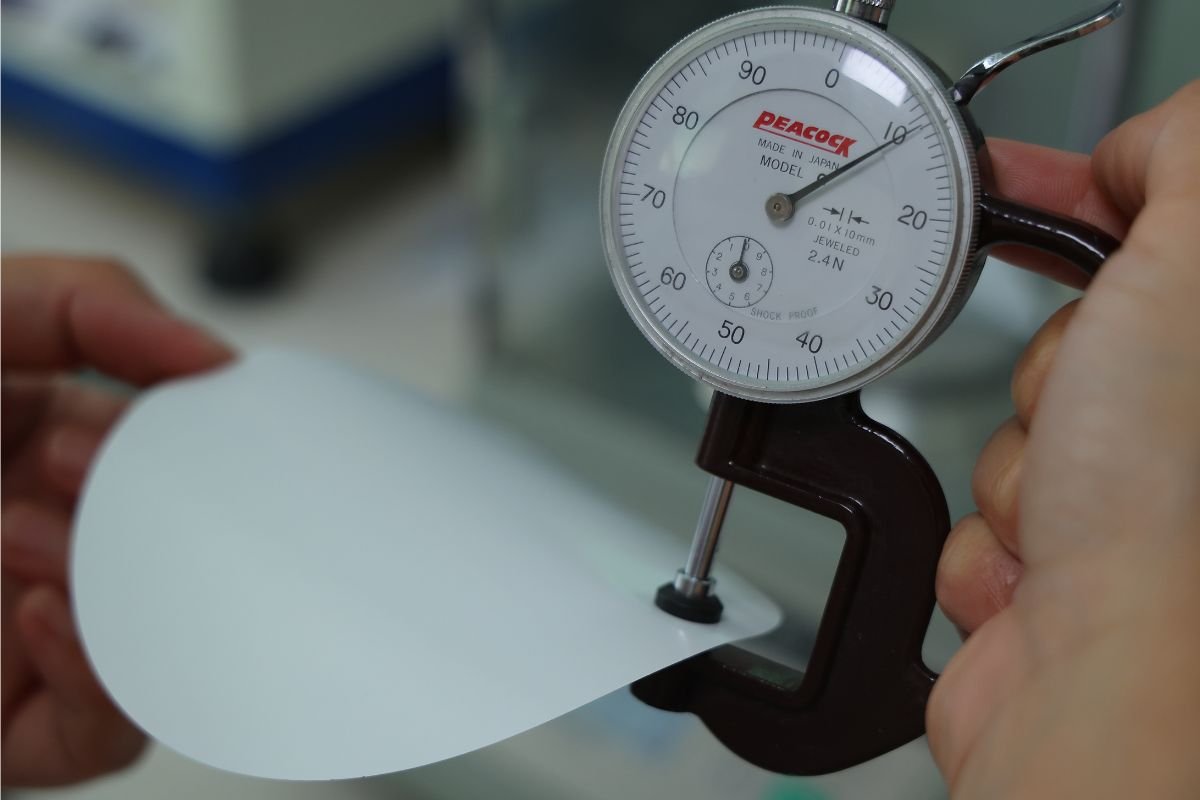
When we talk about thickness, we're considering how the vinyl will be used. Thinner films, usually around 50-70 microns, are more flexible and often used for applications where conformity to curves is important, like partial vehicle graphics or intricate decals. They can be a bit trickier to apply due to their thinness. Cast vinyls, despite their strength, can sometimes be very thin, around 50 microns.
Medium thicknesses, around 80-100 microns, are very common for general signage, window graphics, and flat panel applications. They offer a good balance of durability, ease of handling, and cost-effectiveness. Thicker vinyls, above 100 microns, provide maximum durability and rigidity, often used for floor graphics or protective overlays, but they are less flexible for curved surfaces. Selecting the right thickness impacts everything from installation ease to the longevity of the finished graphic.
Common Self-Adhesive Vinyl Thicknesses
| Thickness (Microns/Mils) | Characteristics | Typical Application |
|---|---|---|
| 50 - 70 µm (2 - 2.8 mil) | Very thin, highly conformable, can be challenging to install. | Vehicle wraps (cast vinyl), complex curves, temporary decals. |
| 80 - 100 µm (3.2 - 4 mil) | Standard range, good balance of durability and flexibility. | General signage, window graphics, flat surfaces, medium-term outdoor. |
| >100 µm (>4 mil) | Thicker, more rigid, offers increased durability and protection. | Floor graphics (with laminate), protective films, industrial labels. |
How Strong is Self-Adhesive Vinyl?
The strength of self-adhesive vinyl is a combination of its film durability and the adhesive bond, critical for its performance in various environments.
Self-adhesive vinyl strength is determined by the tensile strength of the vinyl film and the peel adhesion[^5] of its adhesive layer. High-quality vinyl films are designed to resist tearing and stretching, while strong adhesives ensure the graphic remains firmly bonded to the applied surface, even under environmental stressors like temperature fluctuations, moisture, and abrasion.
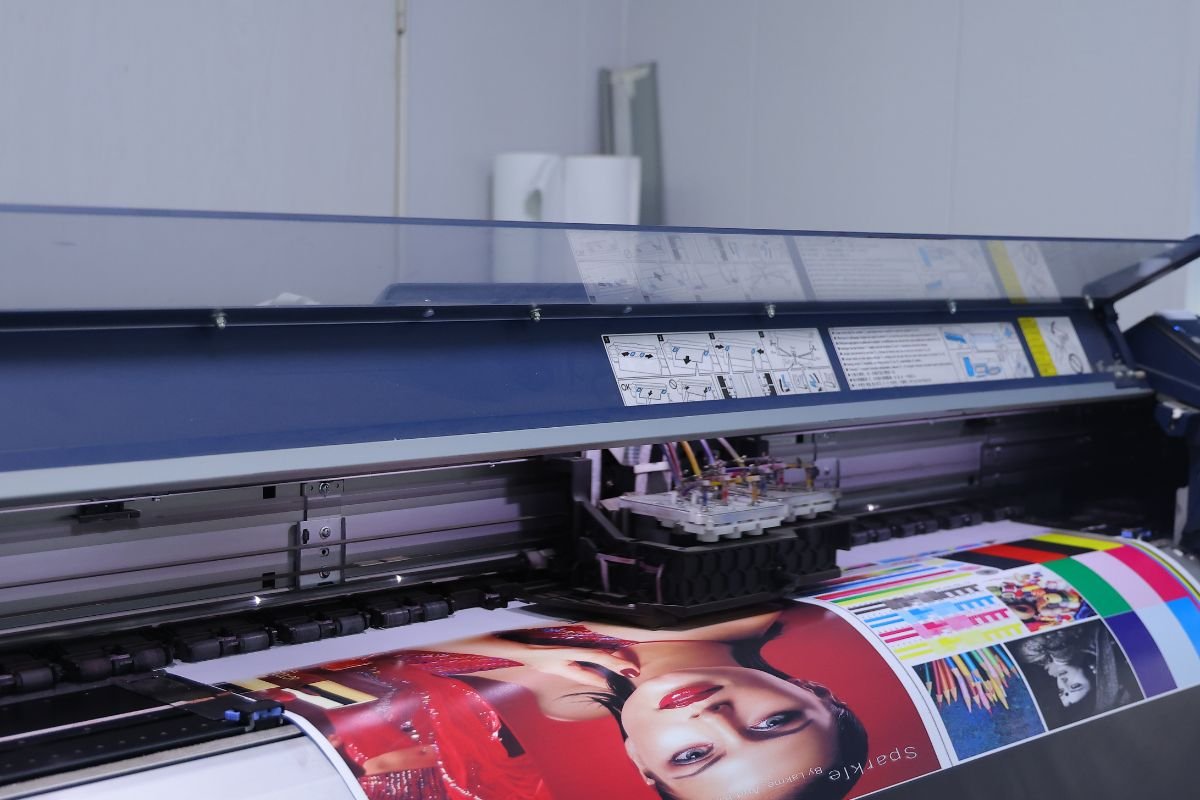
When I assess the quality of self-adhesive vinyl for my customers, I always consider both the film's physical strength and the adhesive's performance. The "tensile strength" of the vinyl film refers to its ability to withstand pulling forces without breaking. This is important for applications that might experience stretching or stress, like banners under tension or vehicle wraps.
Equally important is the "peel adhesion" of the adhesive. This measures how strongly the adhesive sticks to a surface. A strong peel adhesion ensures the vinyl won't lift or curl at the edges, which is a common failure point for lower-quality materials. We test our products rigorously for adhesion in various conditions, including temperature changes and humidity, to ensure that the vinyl stays put over its intended lifespan. This holistic approach to strength ensures our products meet the stringent demands of professionals like Mr. Watford.
Aspects of Self-Adhesive Vinyl Strength
| Aspect | Description | Importance |
|---|---|---|
| Tensile Strength | The vinyl film's resistance to breaking when stretched. | Prevents tearing during application or under stress. |
| Tear Resistance | The film's ability to resist the propagation of a tear. | Crucial for durability, especially in high-stress areas. |
| Peel Adhesion | The force required to peel the adhesive from a surface. | Ensures long-term bonding, prevents lifting/curling. |
| Shear Strength | The adhesive's resistance to forces parallel to the surface. | Prevents sliding or shifting of graphics on vertical surfaces. |
| Dimensional Stability | The vinyl's ability to resist shrinkage or expansion. | Prevents warping or deforming of graphics over time. |
Is Self-Adhesive Vinyl Waterproof?
This is a common question, especially for outdoor and long-term applications.
Yes, self-adhesive vinyl itself is inherently waterproof and weather-resistant, as the vinyl film and most adhesives are designed to repel water. This property makes it highly suitable for outdoor applications, vehicle graphics, and environments exposed to moisture without compromising the integrity of the material or the printed graphic.
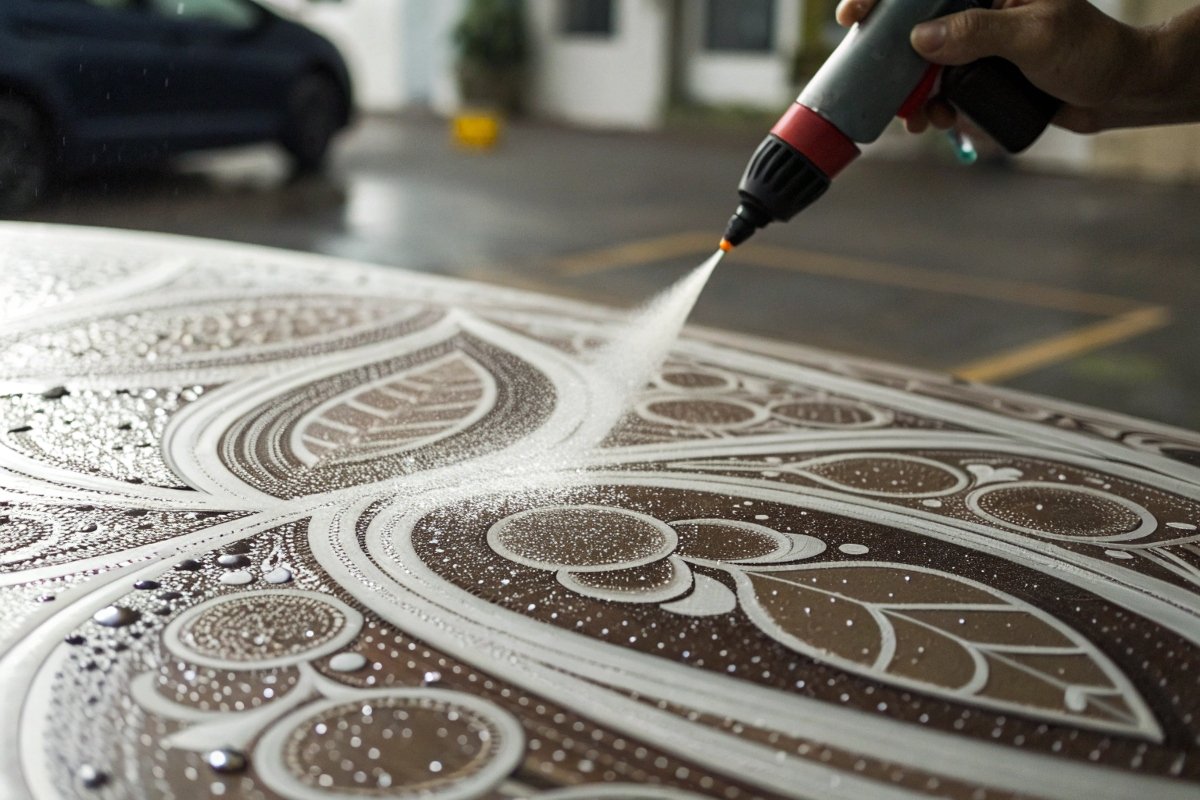
From my perspective, this waterproof quality is one of the biggest advantages of self-adhesive vinyl. Imagine a vehicle wrap that would lose its integrity in the rain, or a window graphic that bubbles up with humidity! The PVC material itself doesn't absorb water, and the adhesives used are formulated to withstand moisture.
However, while the vinyl is waterproof, the longevity of the printed graphic's waterproof and fade-resistant properties depends heavily on the ink type and whether an additional protective laminate[^6] is applied. Solvent, eco-solvent, and UV-curable inks are generally waterproof and highly fade-resistant. Water-based inks, while great for indoor use, might need lamination for outdoor durability. My company always recommends choosing the right ink and considering lamination for anything exposed to harsh weather or frequent washing, ensuring the graphic looks vibrant for its intended life.
How Long Does Self-Adhesive Vinyl Last?
The lifespan of self-adhesive vinyl varies significantly based on its type, application, and environmental exposure.
The lifespan of self-adhesive vinyl ranges from as little as 6 months for temporary monomeric films to over 7 years for high-performance cast films. Longevity is primarily influenced by the type of vinyl (monomeric, polymeric, cast), the quality of the adhesive, whether it is laminated, and exposure to environmental factors like UV radiation, temperature extremes, and abrasion.
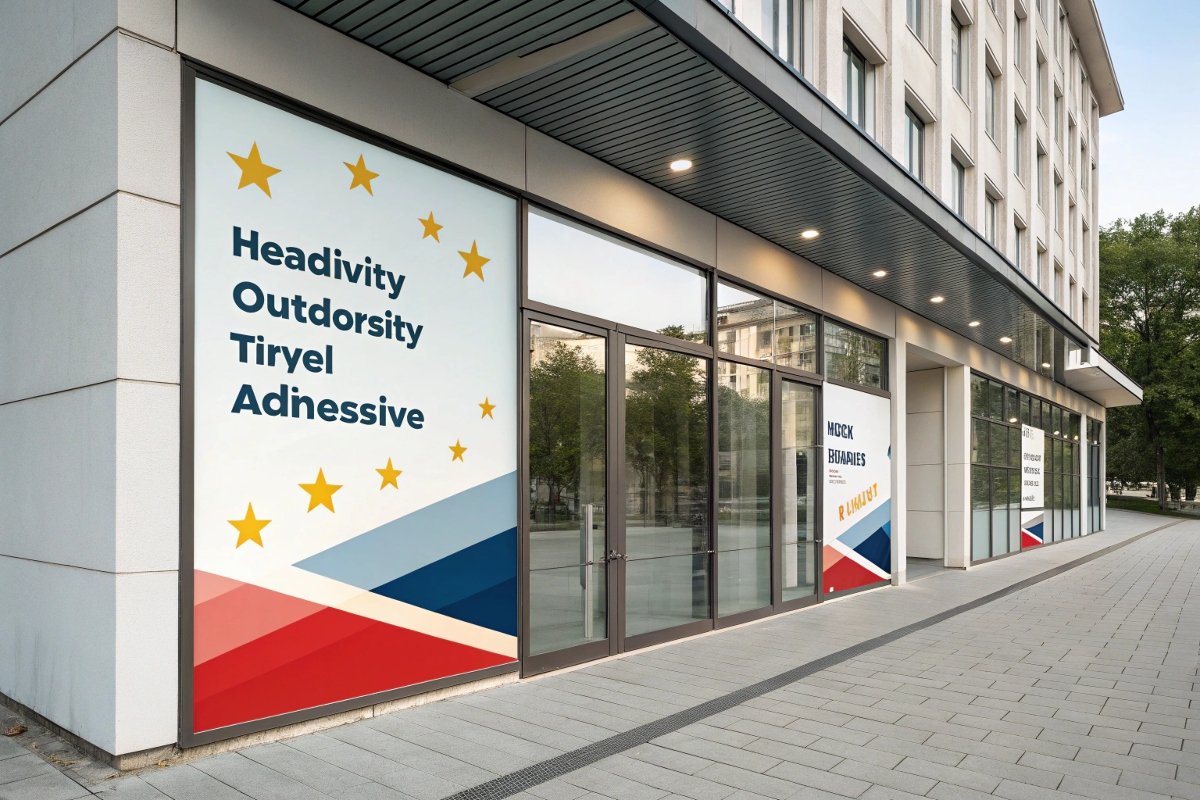
This is where understanding the categories of vinyl becomes crucial for both suppliers and customers. When a client asks how long their graphic will last, my first question is always: "What's the application and how long do you need it to last?"
- Monomeric vinyls are the shortest-lifespan option, typically 6 months to 2 years. They are economical but prone to shrinkage and are best for flat surfaces and short-term indoor or outdoor promotions.
- Polymeric vinyls offer a mid-range lifespan, usually 3 to 7 years. They are more stable than monomeric options and can conform to gentle curves, making them popular for general outdoor signage and fleet graphics.
- Cast vinyls are the premium choice, lasting 7 years or more. They are the most dimensionally stable, highly conformable to complex curves (like rivets or extreme vehicle contours), and resistant to shrinkage, making them ideal for long-term vehicle wraps and demanding outdoor graphics.
Applying a clear protective laminate always extends the graphic's life, shielding it from UV degradation, abrasion, and chemicals. As Mr. Watford aims for reliability and cost-efficiency, understanding these lifespan differences helps him select the most suitable (and thus most cost-effective in the long run) product for his company's needs.
What are the Categories of Printable Self-Adhesive Vinyl? What are the Characteristics of Each Category?
Printable self-adhesive vinyl is primarily categorized by its manufacturing process and chemical composition, which directly impact its performance and application.
Printable self-adhesive vinyl is categorized into three main types based on its plasticizer content and manufacturing method: monomeric, polymeric, and cast vinyl. Monomeric vinyl is generally for short-term, flat applications; polymeric offers a medium-term solution with better dimensional stability; and cast vinyl is the premium choice for long-term, complex, and highly conformable applications.
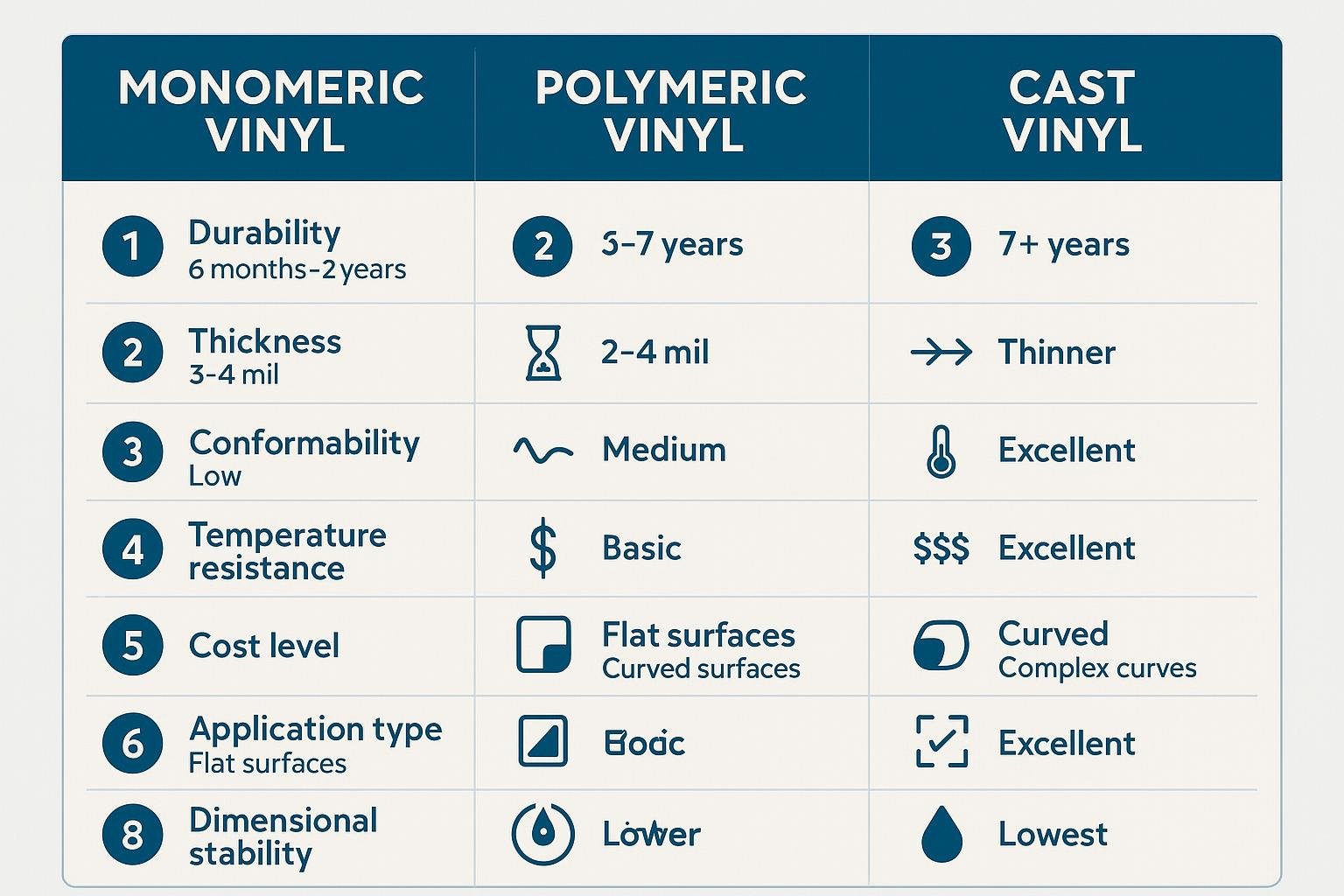
This segmentation is fundamental to my business. When a client asks for "vinyl," I immediately think about these three categories because they dictate everything: cost, durability, conformability, and ease of application.
Monomeric Vinyl: This is the most basic and economical. It uses short-chain plasticizers that can migrate out over time, leading to shrinkage and cracking, especially in outdoor or challenging conditions. It's best for flat surfaces and short-term applications like promotional signage or indoor wall graphics. I typically advise using it for projects that will be displayed for less than two years.
Polymeric Vinyl: This is the workhorse of the industry. It uses longer-chain plasticizers, making it more stable and durable than monomeric film. It shrinks less and can conform to gentle curves. This is my go-to recommendation for general outdoor signage, fleet graphics (flat sides), and medium-term applications (3-7 years). It strikes a good balance between cost and performance.
Cast Vinyl: This is the top tier. Made through a casting process, it's virtually stress-free, meaning it has almost no memory and minimal shrinkage. It's incredibly thin and highly conformable, capable of wrapping complex curves, rivets, and deep recesses on vehicles. Because it's so stable, it offers the best outdoor durability, often lasting 7-10 years or more. While it's the most expensive, its performance for long-term vehicle wraps and demanding applications justifies the cost. Understanding these options allows us to effectively meet diverse project demands.
Categories of Printable Self-Adhesive Vinyl
| Category | Characteristics | Ideal Applications | Lifespan (Typical Outdoor) |
|---|---|---|---|
| Monomeric Vinyl | Most economical, higher shrinkage, less flexible, thicker. | Short-term flat graphics, promotional signage, indoor murals. | 6 months - 2 years |
| Polymeric Vinyl | Mid-range price, good stability, less shrinkage, moderate flexibility. | General outdoor signs, fleet graphics (flat/simple curves), window graphics. | 3 - 7 years |
| Cast Vinyl | Premium price, excellent dimensional stability, very flexible, minimal shrinkage. | Full vehicle wraps, complex curved surfaces, long-term outdoor graphics, fleet branding. | 7+ years |
What is Adhesive Vinyl Used For?
The applications of self-adhesive vinyl are vast, spanning across multiple industries due to its versatility and visual impact.
Self-adhesive vinyl is widely used for a diverse range of visual communication and decorative purposes, including vehicle wraps, window graphics, wall decals, floor graphics, outdoor signage, exhibition stand branding, point-of-sale displays, and even temporary indoor decor, leveraging its ease of application and vibrant print capabilities.
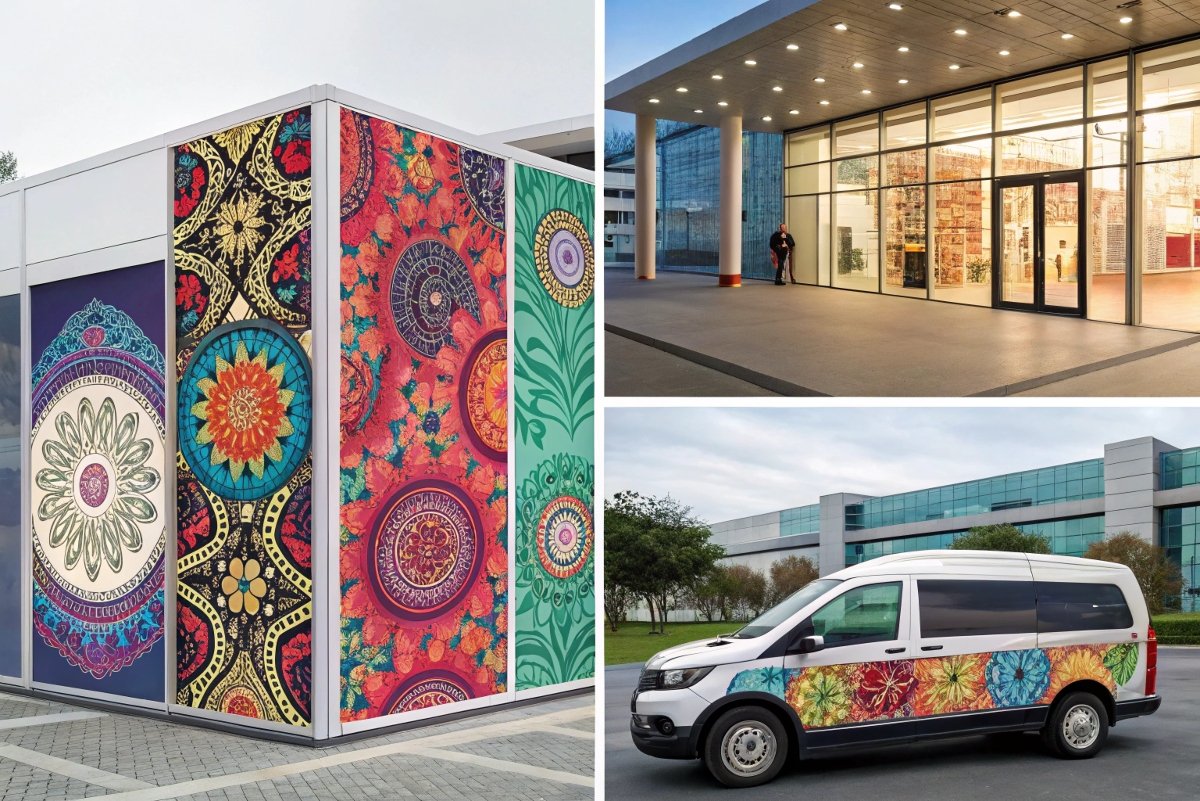
In my decades of work, I've seen self-adhesive vinyl transform almost every surface imaginable. "Vehicle wraps" are a prime example – turning a car or van into a mobile billboard. For businesses, "window graphics" are essential, from displaying opening hours to creating eye-catching storefront promotions that draw customers in. Inside, "wall decals" can customize offices or homes, and "floor graphics" can guide traffic or advertise products in stores.
For outdoor use, it forms the basis for many "outdoor signage" panels. At events and trade shows, "exhibition stand branding" relies heavily on self-adhesive vinyl for impactful, temporary, and easily changeable graphics. Even "point-of-sale displays" are made dynamic with intricate vinyl stickers. Its ability to adhere to various substrates – glass, metal, plastic, smooth walls – makes it an indispensable tool for marketing and interior design professionals.
Common Uses of Self-Adhesive Vinyl
| Application | Description | Example |
|---|---|---|
| Vehicle Wraps & Graphics | Branding and advertising on cars, vans, trucks, and buses. | Full wrap on a delivery van, company logo on a car door. |
| Window Graphics | Promotional messages, branding, or decorative elements applied to glass. | Sale advertisements on storefront windows, privacy film with perforated graphics. |
| Wall Decals & Murals | Interior decoration, branding, or informational graphics on walls. | Large mural in an office lobby, decorative stickers for a child's room. |
| Floor Graphics | Advertisements, wayfinding, or safety messages on floor surfaces. | "Walk this way" arrows in a store, promotional ad at a supermarket entrance. |
| Outdoor Signage | Permanent or temporary signs on rigid boards, facades. | Shop fascia signs, construction site warnings. |
| Exhibition Stands | Branding and visual displays for trade shows and events. | Panel graphics for a modular exhibition booth. |
| Point-of-Sale (POS) Displays | Small graphics and stickers for product promotion at retail checkouts. | Discount stickers on product shelves, counter graphics. |
| Labels & Decals | Product labeling, branding stickers, safety decals. | Company logo stickers, equipment warning labels. |
Conclusion
Self-adhesive vinyl is a versatile, printable film made of layered PVC, adhesive, and a release liner. It's manufactured through calendering or casting, varies in thickness, boasts strength from its film and adhesive, and is waterproof. Categorized as monomeric, polymeric, or cast based on durability, it's used extensively for vehicle wraps, window graphics, and various signage applications, with its lifespan largely determined by type and lamination.
Annotated Reading:
- PVC (Polyvinyl Chloride): A widely produced synthetic plastic polymer known for its versatility, durability, and water resistance, making it ideal for self-adhesive vinyl films. https://en.wikipedia.org/wiki/Polyvinyl_chloride
- Monomeric Vinyl: A type of calendered vinyl film that uses short-chain plasticizers. It is less stable and more prone to shrinkage and cracking over time, suitable for short-term, flat applications.
- Polymeric Vinyl: A type of calendered vinyl film that uses longer-chain plasticizers, making it more dimensionally stable and durable than monomeric vinyl, suitable for medium-term applications and gentle curves.
- Cast Vinyl: A premium type of vinyl film produced by pouring liquid PVC onto a highly polished surface and drying it. It is very thin, highly conformable, and dimensionally stable, ideal for long-term applications, especially complex curves and vehicle wraps.
- Peel Adhesion: A measurement of the force required to peel a pressure-sensitive material from a given surface at a specified angle and speed. It indicates how strongly the adhesive grips the substrate.
- Laminate: A clear, protective layer (usually a film) applied over a printed graphic. It enhances durability, protects against UV fading, abrasion, moisture, and chemical exposure, and can alter the finish (e.g., gloss, matte).


